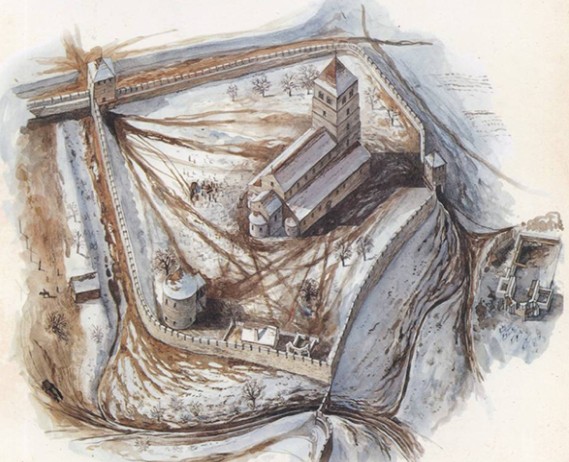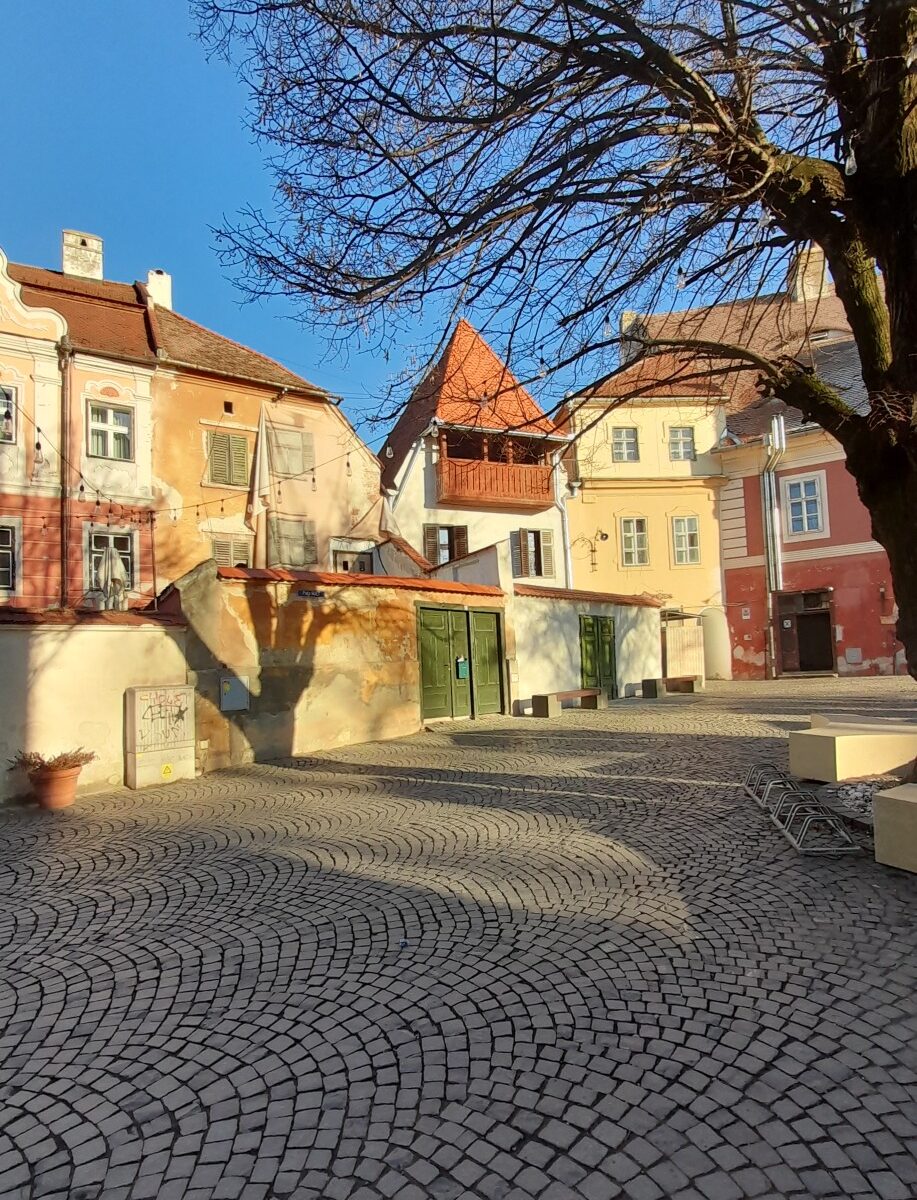Huet Square is the spot from which medieval Sibiu bloomed during the Middle Ages, when Europe was expanding and bursting its banks (population-wise) spilling eastwards. Mignon, magical, legendary, discover with me Huet Square Sibiu, the essence of legends.
Huet Square is located in the heart of modern-day Sibiu. Let’s stroll around it.

Some of these buildings stand where the first wooden houses once stood, followed by the first wooden fortification of Sibiu. They surround and protect its heart: in the middle of Huet Square is the Evangelic Church.
Huet Square by night, although as bright as daylight!

The heart, the hearth, and the promise of a better life in a new land, a promised land and one free of taxes, set many merchants and the peasants from Flanders and Rhine Valley on their quest. So they came by foot, by cart, by horse. Traveled during daylight over green hills, slept under a canopy of stars and the vigil watch of men, and of prayer. Left a known life, a lesser life, for the unknown. All for the sake of a promise made by King Geza II of Hungary.
…Although, the word of mouth would have worked during Medieval Europe as it dose today. The Teutonic Knights, first in these woods of Transylvania, would have let other know of its incredible rich soil…
Same gate, day and night – although it is open at night time. You can see there’s an inner yard:


During their travel, had the Saxons (how they were known later) spent sleepless nights, clawed by apprehension? By second thoughts? Had they set foot forward hunched under the mantle of unease? Some whisper, and with good cause, that this massive migration taking place in waves has left its mark not only on the history of Europe, but on its folklore and literature too and is remembered today as the story of Pied Piper of Hamelin.
Countless other incredible legends were born around Sibiu and I wrote about a few in my latest book, Dreamland: The Giants from Cristian, Legendary First Saxons of Transylvania, Towering at Carta Mnastery, A White Lie on the Lie Bridge, Vein Victims of Transylvania’s Tallest Tower:

By the sweet springs of Cibin the settlers stopped. The forests here had good game (which they could hunt, as king’s guests), and water of aplenty. The air was cooler, sweeter too. And there were lush pastures for their cattle, enough wood for shelter, and no sounds penetrated the curtain of trees. None other but the snorting of their horses and the cry of a babe. It was peaceful. It was sunny. They’d come home, after more than one month of traveling, of living a nomad life that wasn’t theirs. Now, they could set the foundation for the life they wanted, like the one they’ve been accustomed with, but better – especially for the generations to follow.


The craftsmen set building on the shores of a lake, near Cibin River, by Cibin, wooden homes with small holdings, and a wooden chapel (a rotonda with a crypt) worthy of their times, the 1150s. A street soon emerged, dotted with workshops, a lime kiln, and the market.
Below: Huet Square, day/night, buildings side by side, near the place where the first rotonda church once stood. Notice in the day picture, on the ground level of the yellow building (14th century) a narrow passage: the Shoemakers’ Passage (Schusterloch) leading to the Small Square.


The beginning of Sibiu (first known as Cibin) happened where Huet Square is found today, as well as the adjoining Goldsmiths’ Square, Piata Aurarilor, Silvermiths’ Street, and Târgului Street, The Fair Street – quite fitting, isn’t it? in what is today known as Lower City.
It would have looked like this:

By 1191 the head of Sibiu’s clergy is already recognized by Pope Celestin III and this document is the oldest known to certify Sibiu.
Hermannsdorf (villa Hermanni) emerged soon after, the Village of Hermann and, yes, it comes with a legend.
Soon the village receives the Andreanum Diploma (1224) from King Andrew II of Hungary (Transylvania was part of the Hungarian Kingdom then) and this recognizes more economical, political and religious privileges for the Saxons of Sibiu. The Saxons could freely own the land from Orăştie la Drăuşeni (known as fundus regius, Königsboden, royal ground, they were all equal (remember, it was still Feudal Era in the rest of Europe), they were free to choose their political and religious rulers (this meant bypassing the power of the Voievode of Transylvania), free to trade within the Hungarian Kingdom without paying border taxes (one collective yearly tax was to be paid on St Martin’s day, 11 November, only), and could apply their own justice, “ius gladii”, the right of the sword, to have their own judge and apply the capital punishment.
But there was a catch, the Saxons had to provide troops for the King’s army, to defend the crown, ad retinendam coronam, which was mentioned on Sibiu’s medieval seal too.
Samuel von Brukenthal National College in Huet Square, the building below dating from 18th century, the school first mentioned in 1380, is the oldest German-speaking school in Romania:

And 90 minutes later, at 6pm:

In 1321 Sibiu is mentioned as Hermannsdorf (the Village of Hermann) in documents and a few decades later as Hermannstadt (the City of Hermann).
But before the 14th century Sibiu had to survive the great Mongol Invasion of 1241, and this meant more changes…
One more look at Huet Squre from the schoolyard of Brukenthal Highschool, the statuary Evangelic Church (which we’ll visit next time) on the left:

For Dan Antion’s Thursday Doors weekly challenge – go see some great doors, worldwide.
More to come – so subscribe no my newsletter or follow the blog and never miss a story:
Houses, doors, and a STORY on Târgului Street Sibiu – and a dog!
The whimsical Piata Aurarilor, Goldsmiths Square Sibiu, and the STORY of a Mongol Invasion
The Legend of Clever Hermann, How Sibiu Got its Name.
Going through the Shoemakers’ Passage (between Huet and Small Squares) – with VIDEO
The Medieval and Legendary Small Square of Sibiu by Night & Day!
Staring at Whimsical Casa Calfelor (The Apprentices’ House) in Huet Square
Climbing the Tower of the Evangelical Church to the Top, and peeking into its four turrets – with video
Up the stone spiral staircase of the Evangelical Church – with video
More Secret Passages in the middle of Sibiu – Lost in Time
Having a Peak Under the Evangelic Church
A Shakespearean Murder – Mihnea the Bad (cel Rău), Vlad the Impaler’s Son
Over and Under the Bridge of Lies, it’s Sibiu!
Bending Low to Climb the Council Tower
The Pharmacy Museum, First and Oldest in Romania
A 13th Century AND a First Hospital
More to come – so subscribe no my newsletter or follow the blog and never miss a story:
Houses, doors, and a STORY on Târgului Street Sibiu – and a dog!
The whimsical Piata Aurarilor, Goldsmiths Square Sibiu, and the STORY of a Mongol Invasion
The Legend of Clever Hermann.
Going through the Shoemakers’ Passage (between Huet and Small Squares) – with VIDEO
The Medieval and Legendary Small Square of Sibiu by Night & Day!
Staring at Whimsical Casa Calfelor (The Apprentices’ House) in Huet Square
Climbing the Tower of the Evangelical Church to the Top, and peeking into its four turrets
More Secret Passages in the middle of Sibiu – Lost in Time
Having a Peak Under the Evangelic Church
A Shakespearean Murder – Mihnea the Bad (cel Rău), Vlad the Impaler’s Son
Over and Under the Bridge of Lies, it’s Sibiu!
Bending Low to Climb the Council Tower
The Pharmacy Museum, First and Oldest in Romania
A 13th Century AND a First Hospital


Wonderful photo! Happy Women’s Day! Thank’s Patricia.
Thank you so much, Elvira! Happy Women’s Day to you too!
I am glad you enjoyed my story about the beginnings of Sibiu!
I thought you were doing some world building here, but then I found that the location is real. A lovely introduction to the place
Oh, my, I’ll take this as a major compliment . Thank you!
Sibiu is as real as they come. Amazing to visit, to be there and take it in.
And flooded with lights as soon as night descended – I was impressed, although we came from Bucharest, the capital city of Romania!
Here, in South Africa, is mostly pitch dark.
Wonderful photos and you know I always enjoy the history. I have your book of 100-Word stories. I need to finish that. We think about travel today, to visit places. I moved coast-to-coast in the U.S. (twice) but not like migrating to a distant and unknown land. This is a fascinating place and I’m glad you’re bringing us back.
My family has life-long connections with that part of the country and with Sibiu. It has a special place in my heart and I am excited that I could take my husband and my children there. It’s five hours by train from Bucharest, so not within easy reach.
There will be plenty more to come, some incredible photos and places.
Migrating to a new land is a lot scarier if you have a family depending on you, not as much if you’re young (as I was when I moved to SA).
I hope you will enjoy the read, Dan. Thank you.
I am enjoying the stories. Moving cross-country, knowing that we could call home for support at any minute, wasn’t that scary. We didn’t have to, and we were driving on modern highways, not traveling by covered wagon 😉
I read the other day (after the blog post came out, so now I better edit it) that the Saxons might have followed the Roman roads all the way to Transylvania, still easily visible 1000 years ago.
While other sources mentioned the existence of locators who would have persuaded the people to relocate.
But, true, muuuuuch easier now.
Your Huet Square could use a fresh coat of paint, but otherwise it looks quite endearing. And amazing. If only the walls could talk…
Thank you, Jo.
The paint is s a reminder that nothing lasts.
Love your photos and legands.
Ah, you are the sweetest! Thank you, Martie
What a great square and intersection history. Love seeing it in different light. Maggie
Thank you for visiting, Maggie. Always a pleasure having you over.
We had four full days in Sibiu so that’s all did, walking – not counting the Christmas Market and sitting down to eat – somehow in winter meals tend to be longer…
What fun, Patricia, and so interesting! I like the design in the street from the way they laid the bricks. It really adds to the look of the place.
janet
I am glad you noticed the stones used to pave the roads. It’s a kind of granite if I remember correctly. Huet Square would be a pedestrian area, haven’t thought about it until now – which is good because cars make a great deal of noise when driving on roads paved with that kind of stone.
It’s tricky business setting them out like that. It also adds to the charm.
These pictures of Huet Square are beautiful! Thank you so much for making me discover this quaint square and sharing such interesting history about it, Patricia.
With great pleasure, Blanca. Thank you for joining me.